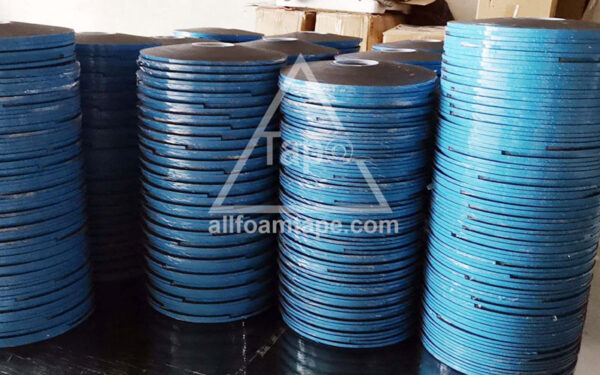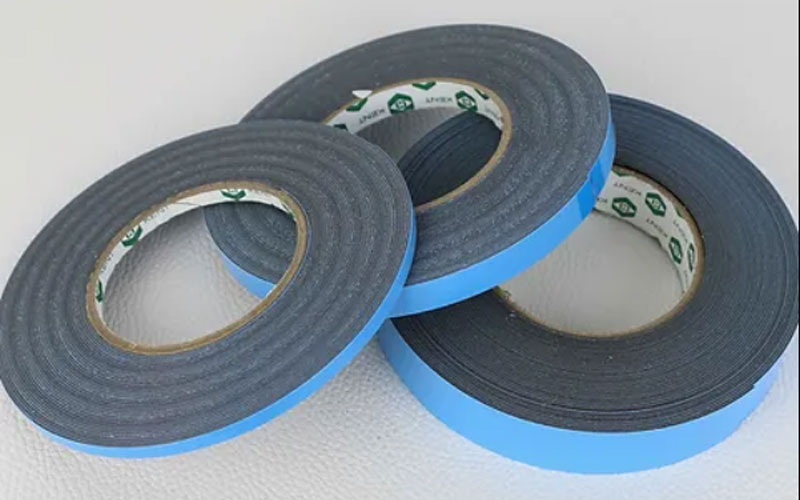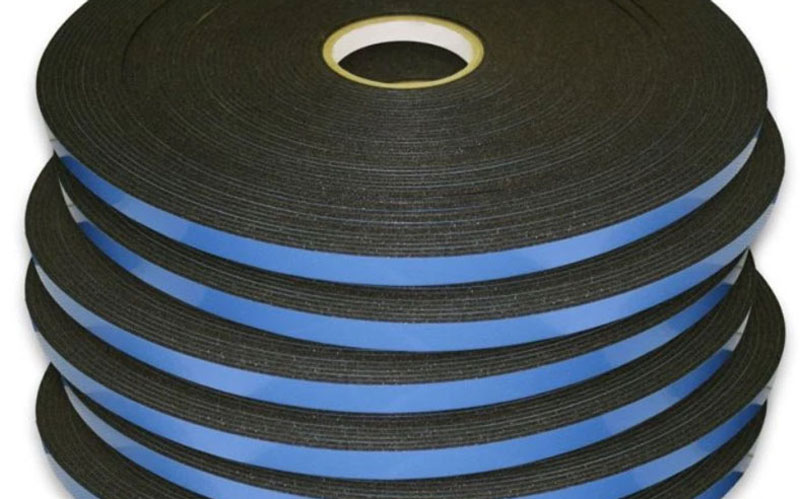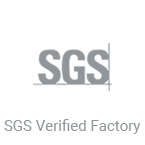Foam tape is a special tape made of a combination of foam material and adhesive, which is widely used in multiple industries and daily life. Foam tape is not only light and flexible, but also has good shock absorption and sound insulation performance. Its main uses include bonding, filling, sound insulation and waterproofing, which can effectively meet the needs of different materials and environments. There are many types of foam tape, including single-sided and double-sided tapes, foams of different materials, and a variety of foam structures and densities. This makes foam tape an indispensable material in all walks of life.
The application field of foam tape is very wide, such as electronics, automobiles, construction, home furnishing and other industries, which are inseparable from this high-performance tape. Users can choose the right foam tape according to specific usage needs and environment to give full play to its superior performance. Through in-depth understanding of foam tape, users can not only improve work efficiency, but also improve the quality and service life of the final product. Now follow Toptape to get the ultimate faq guide to foam tape:

What is foam tape?
Foam tape is a special tape made of a foam material (such as polyvinyl chloride PVC, ethylene-vinyl acetate copolymer EVA, polyethylene PE, silicone, etc.) combined with an adhesive (such as acrylic glue, rubber glue, silicone glue, etc.). Its foam layer usually has good cushioning properties and flexibility, making it excellent bonding, filling, sound insulation and er-proofing. The diversity of foam tape makes it suitable for a variety of surfaces, including smooth and rough materials, and it can maintain excellent adhesion under different environmental conditions.
The structure of foam tape can be divided into two types: open-cell and closed-cell. Open-cell foam has good air permeability and is suitable for use in applications that require gas circulation, such as packaging of medical devices. Closed-cell foam has excellent sound insulation and waterproof properties and is often used in automotive sealing, building sound insulation and other occasions. In addition, the thickness and density of foam tape can be customized according to actual needs to meet the requirements of different applications.
The application of foam tape is not limited to simple bonding. In electronic products, it can protect circuit boards from shock and vibration; in the construction industry, foam tape is used to seal doors and windows to prevent air and moisture penetration. These applications fully demonstrate the versatility and adaptability of foam tape, making it an important auxiliary material in modern industry.

Types of Foam Tape
Foam tape is rich in variety and can be classified according to different standards, mainly including the following aspects:
Classification by Pasting Method
Classification by material
- PVC foam tape: PVC foam tape has good abrasion resistance and water resistance, and is suitable for sealing and waterproofing in the construction and automotive industries.
- EVA foam tape: EVA foam tape is widely used in electronic product packaging and household items due to its softness and excellent adhesion.
- Silicone foam tape: This type of foam tape has good high temperature resistance and is suitable for special industrial applications, such as protection of electronic components in high temperature environments.
- PE foam tape: PE foam tape is soft and has good impact resistance, suitable for packaging and protecting materials.
- Acrylic foam tape: This type of tape has excellent performance and is suitable for occasions requiring long-term bonding and has good weather resistance.
- Chloroprene/EPDM/SBR foam tape: Foam tapes of these materials have good weather resistance and chemical resistance, and are suitable for special applications in the automotive and construction industries.
- Open-cell foam: Open-cell foam is breathable and suitable for use in applications that require gas circulation, such as packaging of medical devices.
- Closed-cell foam:Closed-cell foam has good sound insulation and waterproof properties, and is suitable for sealing and heat insulation applications.
Classification by foam type

Main uses of foam tape
Foam tape is widely used in many industries due to its superior performance and versatility. Here is a detailed introduction to some of the main uses:
- Construction industry: Foam tape plays an important role in construction and decoration, mainly used for door and window sealing, wall sound insulation and waterproofing. The use of foam tape can effectively prevent the penetration of air and moisture and improve the energy efficiency of buildings. For example, when installing windows, the use of foam tape can form a good seal between the window frame and the wall to avoid air infiltration, thereby improving the thermal insulation performance of the house. In addition, the sound insulation effect of foam tape can reduce the transmission of indoor and outdoor noise, creating a more comfortable living environment.
- Automotive industry: In automobile manufacturing, foam tape is often used to fix interior parts, shock absorption and sealing components. By using foam tape in car assembly, the impact of vibration on components can be reduced and the service life can be extended. At the same time, foam tape also plays an important role in the sealing of car windows and doors to ensure the waterproof performance and air tightness of the vehicle. For example, the foam tape in the car door can effectively prevent rain from penetrating into the car and keep the car dry.
- Electronics industry: In electronic products, foam tape is widely used to protect and fix circuit boards to prevent short circuits and electrostatic interference between components. The shock-absorbing properties of foam tape can effectively protect the safety of electronic products during transportation and use, and reduce the risk of damage. In addition, foam tape can also be used to connect and fix cables to ensure the stability and safety of cables, especially in high-vibration environments.
- Household items: Foam tape is also widely used in the assembly and installation of furniture. It can be used to fix decorative materials, shock absorption and protection on the surface of furniture, and enhance the aesthetics and performance of furniture. For example, foam tape can be used to fix sofa legs to prevent them from scratching the floor, and it can also effectively absorb shock and reduce the noise of furniture.
- Packaging industry: In the packaging field, foam tape is used to protect products and fix packaging materials. By using foam tape, it is possible to effectively prevent wear and collision of products during transportation and ensure that the products arrive at their destination safely. In addition, when sealing the package, foam tape can prevent dust and moisture from entering, improving the safety of the package.
In summary, foam tape is widely used in multiple industries, fully demonstrating its versatility and practicality. By understanding the different uses, users can better choose the right foam tape to meet specific application needs.

Adhesive Types of Foam Tapes
The type of adhesive used in foam tape directly affects its performance and scope of application. Commonly used adhesives mainly include the following:
- Acrylic Adhesives: Acrylic adhesives are high-performance adhesives with excellent weather resistance and adhesion, suitable for indoor and outdoor environments. It can maintain stable adhesive properties at high and low temperatures, so it is widely used in the construction, automotive and electronics industries. Acrylic adhesives also have excellent UV resistance and are suitable for applications exposed to sunlight.
- Adhesive Rubber: Rubber adhesive is one of the most commonly used adhesives, with good initial adhesion and tensile strength. It is suitable for a variety of surfaces, especially irregular surfaces. Rubber adhesives perform well in high humidity environments and are suitable for various applications in the home, office and industrial fields, such as fixing electronic components and assembling furniture. However, rubber adhesives have poor high temperature resistance and prolonged exposure to high temperature environments may cause adhesion to decrease.
- Silicone adhesives: Silicone adhesives are widely used in special fields due to their resistance to heat, water and chemicals. They can still maintain excellent adhesion at extreme temperatures (up to 200°C or more), making them suitable for high-temperature applications in the electrical, automotive and construction industries. Silicone adhesives also have good elasticity and can maintain their adhesion properties when the temperature changes, which is suitable for applications that require dynamic movement.
The properties of foam tapes vary depending on the adhesive used. Choosing the right adhesive not only ensures the adhesion and durability of the tape, but also improves the quality of the final product. When choosing foam tape, users should choose the right type of adhesive according to the specific application requirements and environmental conditions to achieve the best use effect.
Advantages of Foam Tape
Foam tape has many significant advantages due to its unique structure and materials:
- Excellent shock absorption performance: The softness of foam material enables it to effectively absorb vibration when it is impacted and protect the adhered object from damage. This feature is particularly important in electronic products, automobiles and household goods, which can reduce the risk of damage during transportation and use.
- Good sound insulation effect: Due to its special foam structure, closed-cell foam tape can effectively isolate noise and is suitable for places that require a quiet environment, such as offices and homes. Their application in the construction and automotive industries can significantly improve the sound insulation effect and enhance the comfort of living and driving.
- Waterproofness: Most foam tapes, especially closed-cell foam, have excellent waterproof properties and are suitable for sealing in buildings and automobiles. They can effectively prevent moisture penetration, protect internal materials from moisture, and extend the service life of the product.
- Strong adaptability: Foam tape can effectively adhere to a variety of surfaces, including metal, plastic, paper and glass. This feature makes it widely used in various industries, not limited by materials.
- Easy to operate and install: Foam tape generally has good operability, and users can easily cut and apply it according to their needs. Even on small or irregular surfaces, foam tape can be easily installed, which improves the flexibility and convenience of use.
- Environmental protection: With the improvement of environmental awareness, many manufacturers have begun to produce foam tapes made of recyclable and environmentally friendly materials. These tapes have less impact on the environment during production and use, and meet the requirements of sustainable development.
Introduction to the length and width of foam tape
The length and width of foam tape are important factors to consider when selecting and using, and are usually determined according to specific application requirements. The standard length and width of foam tapes have a wide range, and users can choose the appropriate specifications according to actual needs. The following are some detailed introductions to the length and width of foam tape:
- Length: The length of foam tape is usually provided in rolls, and the length of standard rolls ranges from 10 meters to 100 meters. Some special-purpose tapes may provide longer options. Users can choose the appropriate length according to the needs of the project to avoid frequent replacement of tapes. For large-scale industrial applications, choosing a longer roll can reduce the cost of use and improve work efficiency; while in small projects or home use, a shorter roll of tape is easy to carry and store.
- Width: The width of foam tape usually ranges from a few millimeters to hundreds of millimeters, and the specific width selection depends on the size and shape of the object to be bonded. Narrower tapes are suitable for delicate work, such as fixing and decorating electronic components, while wider tapes are suitable for large-area bonding and sealing work, such as splicing of building materials. When choosing the width, users should ensure that it matches the application surface to ensure the best bonding effect.
- Customization options: Many manufacturers provide customization services, and can customize the length and width of foam tape according to the specific needs of customers. This flexibility makes the application of foam tape in specific industries or special projects more efficient.
- Application examples: In the construction industry, foam tapes with a width of 20-50mm are usually used to seal windows and doors, which can effectively prevent moisture and air penetration; in the electronics industry, foam tapes with a width of 10mm are used to fix components to ensure the safety and stability of the product. Choosing the right length and width according to different application scenarios can improve the efficiency of use and ensure the final effect.
By understanding the length and width of foam tape, users can more accurately select and apply foam tape to meet the needs of different projects.

Introduction to the shape of foam tape
The shape of foam tape usually affects its usage and applicable occasions, and can be mainly divided into the following types:
- Roll: Roll foam tape is the most common form, usually sold in roll form, which is convenient for users to cut according to their needs. Roll tape is suitable for large-area applications, such as construction, decoration and rapid bonding of production lines. When using, just cut the required length according to the needs, and the operation is simple and fast. In addition, roll tape is easy to store and suitable for a variety of working environments.
- Sheet: Sheet foam tape is a sheet product that cuts foam tape into a predetermined size, which is suitable for some specific applications, such as fixing or temporary bonding of small electronic products. The size and shape of sheet tape can be customized according to customer needs, which can better meet the needs of specific applications.
- Die-cut shape: Die-cut foam tape is a product that cuts the tape into a specific shape or pattern according to customer requirements. This form of tape is widely used in product packaging, advertising and crafts, and can effectively improve the aesthetics and personalization of the product. Die-cut tape is suitable for applications that require precise positioning or special shapes, such as automotive sealing strips and the fixation of electronic components.
- Other shapes: In addition to the common shapes mentioned above, foam tape can also be customized according to special needs, such as rings, rectangles or other complex shapes. Especially in some complex industrial applications, customers can design the shape of foam tape according to specific needs to achieve better bonding.
By understanding the shape of foam tape, users can choose tape that suits specific application needs and improve work efficiency and bonding quality.
Which industries use foam tape?
Foam tape is widely used in many industries due to its excellent performance and wide applicability. The following are some industries that mainly use foam tape and their application introductions:
- Construction industry: In the construction industry, foam tape is mainly used for sealing doors and windows, sound insulation and waterproofing of walls. The use of foam tape can effectively prevent the penetration of air and moisture and improve the energy efficiency of buildings. Especially when installing windows, foam tape can form a good seal between the window frame and the wall to avoid air leakage, thereby reducing energy consumption.
- Automotive industry: In automobile manufacturing, foam tape is widely used for fixing, sealing and shock absorption of interior parts. By using foam tape in automobile assembly, the impact of vibration on components can be effectively reduced and their service life can be extended. At the same time, foam tape also plays an important role in the sealing of doors and windows to ensure the waterproof performance of vehicles.
- Electronic industry: In the manufacture of electronic products, foam tape is used to protect and fix circuit boards to prevent short circuits and electrostatic interference between components. Its shock-absorbing properties can effectively protect the safety of electronic products during transportation and use, and reduce the risk of damage. In addition, foam tape can also be used to connect and fix cables to ensure the stability and safety of cables.
- Packaging industry: In the packaging field, foam tape is used to protect products and fix packaging materials. The use of foam tape can effectively prevent wear and collision of products during transportation and ensure that products arrive safely at their destination. In addition, foam tape can prevent dust and moisture from entering when sealing the package, improving the safety of the package.
- Household items: Foam tape is also widely used in the assembly and installation of furniture. It can be used to fix the decorative materials on the surface of furniture, reduce shock and protect, and enhance the aesthetics and performance of furniture. By using foam tape, furniture damage can be avoided and noise can be effectively reduced.
- Medical industry: In the medical industry, foam tape is used for packaging and fixing of medical devices, which can provide good protection and sealing performance. At the same time, foam tape can also reduce vibration and protect components during the assembly process of medical devices.
- Aerospace industry: In the aerospace industry, foam tape is used to seal and protect equipment to ensure the stability of equipment in extreme environments. The high temperature resistance and shock absorption characteristics of foam tape make it suitable for application in the aerospace field.
By understanding the application of foam tape in various industries, users can better choose suitable products to meet specific application requirements.

Where can I buy more foam tape?
There are many ways to buy foam tape, and users can choose the right channel according to their needs. The following are some common purchase channels:
- Professional tape suppliers: Many professional tape suppliers provide various types and specifications of foam tape, including standard products and customized services. Through these suppliers, users can get professional advice and services to ensure that they buy the foam tape that suits their needs. Establishing a good cooperative relationship with suppliers can get more favorable prices and higher quality services.
- Online shopping platform: With the development of e-commerce, many online shopping platforms such as Alibaba, JD.com, Amazon, etc. provide foam tape purchase services. On these platforms, users can easily compare foam tapes of different brands and specifications and choose the most suitable products for themselves. The convenience and diversity of online shopping enable users to quickly find the products they need.
- Physical stores: Some building materials markets and hardware stores also sell foam tapes, and users can go directly to buy them. This method allows users to check the quality of the product before purchasing and ensure that they buy the right foam tape.
- Factory direct sales: Some foam tape manufacturers provide direct sales services, and users can purchase through the manufacturer’s official website or by phone. Direct cooperation with manufacturers usually can get more favorable prices and more reliable product quality, especially when purchasing in bulk.
- Exhibitions and industry fairs: Attending relevant industry exhibitions and fairs, users can directly contact multiple foam tape suppliers and learn about the latest product information and market trends. This is a good opportunity to obtain industry information and find partners.
Through the above channels, users can easily purchase suitable foam tapes to meet various application needs.

Is foam tape waterproof?
The waterproof performance of foam tape is one of its important characteristics, and the specific waterproof performance depends on the materials and structure used. The following is a detailed introduction to the waterproof performance of foam tape:
- Closed-cell foam tape: Closed-cell foam is composed of a closed bubble structure, which effectively prevents the penetration of water, so closed-cell foam tapes usually have good waterproof performance. They are often used in sealing and waterproofing applications in the construction and automotive industries, which can effectively prevent moisture from entering, thereby protecting the internal materials from moisture.
- Open-cell foam tape: The structure of open-cell foam has many open bubbles. Although this foam performs well in shock absorption and sound insulation, its waterproof performance is relatively weak. Open-cell foam tapes are generally not suitable for applications that require waterproofing, and users need to carefully consider the actual needs when choosing.
- Material influence: Foam tapes of different materials have different performances in terms of waterproofness. Generally speaking, foam tapes made of materials such as polyvinyl chloride (PVC) and polyurethane (PU) usually have good waterproof performance, while some ordinary polyethylene (PE) foams have poor waterproofing effects. Therefore, when choosing foam tapes, users should pay attention to the material properties and choose products that meet waterproofing needs.
- Application examples: In the construction industry, foam tapes are often used to seal windows and doors to prevent the infiltration of rain and moisture. In automobile manufacturing, foam tapes are used to seal the body of the vehicle to ensure the safety of the vehicle in rain and humid environments. For applications that require waterproofing, users should choose closed-cell foam tapes and ensure the quality of installation to achieve the best waterproofing effect.
In short, the waterproofness of foam tapes is an important consideration in its selection and application. Users should choose the right foam tape according to specific application requirements to ensure the best waterproofing performance.

Precautions when using foam tape
When using foam tape, precautions can help users give full play to the performance of foam tape and avoid common usage errors. Here are some precautions when using foam tape:
- Choose the right type: Choose the right type of foam tape according to the actual application requirements, including material, thickness, width and adhesive type. Different foam tapes are suitable for different environments and surfaces. Making sure to choose the right product can improve the bonding effect.
- Ensure the surface is clean: Before applying foam tape, always make sure that the surface of the object to be adhered is dry, clean and grease-free. Any dirt, dust or grease will affect the bonding effect and cause the tape to not adhere firmly.
- Avoid extreme environments: When using foam tape in environments with extreme temperatures or high humidity, choose a specially designed weather-resistant tape. Some tapes may lose adhesion at high temperatures or high humidity, so it is important to understand the environmental conditions.
- Apply appropriate pressure: When applying foam tape, applying appropriate pressure will help ensure a good bond. Using the palm of your hand or a pressure roller to apply pressure evenly can help the tape adhere better to the surface.
- Leave space: When applying foam tape, make sure to leave some space so that the tape can expand and contract freely. This feature is particularly important in environments with large temperature changes, where too tight a sticking may cause the tape to tear or break.
- Regular inspection: For foam tapes that are used for a long time, it is recommended to regularly check the adhesion to ensure that there is no loosening or falling off. If the adhesive performance of the tape is found to have deteriorated, it should be replaced in time.
- Storage conditions: Unused foam tapes should be stored in a dry, cool environment away from direct sunlight and high temperatures to extend the shelf life of the tape.
By following the above precautions, users can get better results when using foam tape and ensure the quality and durability of the product.
Foam tape is a versatile bonding material that is favored by various industries due to its unique characteristics and wide application. When selecting and using foam tape, understanding its types, adhesive types, advantages, shapes, and related application industries can help users use this material more effectively. At the same time, paying attention to usage methods and maintenance recommendations can improve the efficiency and durability of foam tape. I hope this guide can provide users with comprehensive knowledge of foam tape and help them achieve the best results in practical applications.





